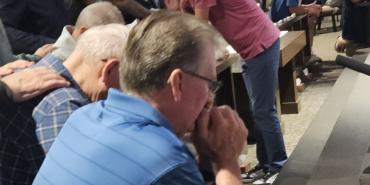A Growing Affinity

From its inception, the church of Jesus Christ has been called to go “into all the world.” As the earliest disciples learned, the Matthew 28 Great Commission did more than expand the geographical presence of the church. It also communicated a call to expand the cultural and linguistic dimensions of the Kingdom of God.
Since the initial commission, the church has sought to find creative ways to “proclaim the good news.” In the 1980s and 1990s, the church growth movement was developed. A major teaching was the concept that “like attracts like.” This was known as the homogenous unit principle: if we attract a growing number of, for example, suburban baby boomers (born between 1946 and 1964) longing for connection, they will connect with others of like circumstance, and in areas where there are many of these boomers, churches are bound to grow numerically. For a short time, this proved to be the case.
There was a downside, though. Target populations in most “attractional churches” became more mobile, and in areas where the boomer age group began to migrate or grow older, churches saw decreases and even closures. In recent years, congregations that once thrived by marketing to “up and coming” young adults have been faced with the reality that—to paraphrase Jesus—those who live by marketing and flashy appeal also die by such things.
Consequently, statistics over the past decade have shown steady decline among the “seeker-sensitive” churches that once thrived at the heart of the church growth movement. Churches that seemed to benefit from this new approach a few decades ago still may lead their Nazarene districts in attendance but are experiencing only a small percentage of the attenders they once welcomed every Sunday morning.
From Attractional to Missional
We’re now seeing a shift to what has been termed a more “missional” approach. Among other things, missional models tend to concentrate more upon what the church does when it leaves Sunday morning worship, rather than upon strategies to bring more worshipers into services on a given Sunday.
Numbers still matter in a missional model, but the emphasis is upon total community impact rather than getting people “in the seats” for a worship experience.
Missional models also seem to be rediscovering the ancient roots of Christian worship and theology in ways that were seen as less important or even detrimental to the previous generation’s approach to “growing the local church.”
Baby boomers who attended seeker-sensitive churches have a hunger for spiritual depth for themselves and for their children, many of whom no longer call the church their home, at least in the way their parents did. The missional model of church appears to be addressing that hunger. Yet, churches are still trying to discern the balance between attractional and missional health and growth.
Connection via Common Interests
Into this struggle comes yet another approach: “affinity churches.” These are churches seeking to connect with a particular lifestyle or a set of common interests to provide tailored worship opportunities that incorporate such lifestyles or interests. These interests or affinities may be deemed “cultural” in nature, or they may simply take seriously certain social or political trends within unreached or unchurched groups.
One example of affinity ministries involves those interested in motorcycles. Some Nazarene churches have started biker ministries in their communities, and there are even biker churches that seek to provide a place of fellowship, Bible study, and discipleship for those involved in the biker culture (from avid riders to hobbyists). Nazarene Biker Fellowship (NBF) is one example.
Another example is “cowboy churches.” This affinity group is fast-growing in the Church of the Nazarene and seeks to connect with individuals and families who may have not found a comfortable home in other church settings and who practice or are drawn to the traditional culture, dress, and values of “cowboy culture:” ranchers, horse lovers, farmers, and so on. The Church of the Nazarene’s USA/ Canada Region’s website lists the affinity group for this movement as “those in the [U.S.] Western heritage culture.”
Most cowboy churches meet in a barn or a rodeo arena and utilize Western-style music. Activities center on the outdoors and rodeo-type events. The churches tend to be “unapologetically conservative in their politics and emphasize the importance of male leadership in church life,” according to one district leader.
Facing the challenges
While affinity groups have always existed as part of local church outreach (men and women’s ministries, youth, children, and so on), many denominations such as the Church of the Nazarene have sought to broaden the range of affinity groups in order to connect to a wider group of unchurched (or formerly churched) people. Some of these affinity groups have even gained status as a multicultural group and not simply a collection of people who share similar interests.
Leaders of affinity church movements point to the missional aspects of their individual churches: people are attending affinity churches each week who had previously abandoned church or never before set foot in worship gatherings. Instead of feeling that the church had no place for them, those involved in affinity churches claim that they have found ways of expressing their faith that connects with them and brings them into the Christian faith.
Even with their short-term successes, affinity churches face questions regarding their future:
- How will those involved in affinity churches foster a deeper connection to the historic Christian faith?
If affinity churches remain content with simply reaching a particular demographic to gather together each week, will these gatherings always see themselves as “outsiders,” or will they build into their own discipleship a connection to the wider church and to the historic Christian faith?
- Will political leanings limit the scope of connection even within their own demographic or affinity?
In other words, would a person in cowboy or biker culture whose political views may be different from the majority of the group feel disconnected, even if he or she has an affinity for the overall culture? Churches are filled with people who have a variety of political leanings. But affinity churches in particular, given their tendency to attract those who share many cultural and political views, must guard against possible political and social barriers that would prevent seekers within their affinity groups from hearing the gospel.
- What happens when the approach of affinity groups come into conflict with denominational norms or doctrines?
In a movement like the cowboy church, the emphasis is upon male leadership. Though women who attend these churches, even in the Church of the Nazarene, tend to overlook this emphasis, due to the increased involvement of unchurched males, how will future interactions on a denominational level affect such differences?
A church or denomination can use these differences as means of educating newcomers, but the nature of affinity churches may risk seeing possible educational opportunities as impediments to the celebration of particular aspects of what is deemed to be the affinity group’s culture.
Open Door or Closed Community?
In a sense, the earliest gathering of Christians was an affinity movement. Often referred to in ancient documents as a “radical Jewish sect,” early Christians saw great growth in and around Jerusalem. The Book of Acts as well as the writings of the Apostle Paul note key instances where conflict arose as the church became less of an affinity group and more diverse in regard to race, culture, and even political leanings.
However, built into their affinity and common backgrounds was a call to “go into all the world” (Matthew 28:18-20), which included ethnicities and affinities outside of Jerusalem: “Judea, Samaria, and the ends of the earth” (Acts 1:8). Can affinity churches be an open door to bring unchurched people into the greater body of Christ, or will the desire to grow together in regard to these particular affinities create pockets of closed communities within the body of Christ?
The future of affinity churches, like the future of every local church in the history of Christianity, is bound up in this balance: reaching those in particular areas and with particular affinities while keeping Jesus’s call to reach “the ends of the earth” in view.
Charles W. Christian is pastor of the Church of the Nazarene in Cameron, Missouri*, and author of the forthcoming book, Ethics in Christian Ministry: A Guide for Pastors and Mentors (Beacon Hill Press).
References:
- usacanadaregion.org
- usacanadaregion.org/ministries/sdmi/nazarene-motorcycle-fellowship
- usacanadaregion.org/cowboy-church
- hoperiders.org
- nazarene.org/tags/multicultural-ministries
- Special thanks to Randy Berkner, superintendent of the North Arkansas District, for an interview regarding cowboy churches.
*Charles W.Christian is now Managing Editor of Holiness Today (May 2017)
Holiness Today, Jan/Feb 2017
Please note: This article was originally published in 2017. All facts, figures, and titles were accurate to the best of our knowledge at that time but may have since changed.




